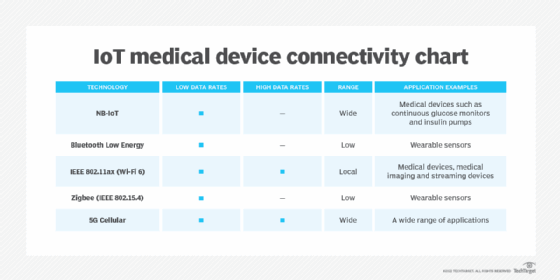
Getty Images/iStockphoto
A guide to networks for IoT healthcare devices
Healthcare IoT use cases are growing -- and admins must know what networks can support these devices. Familiarize yourself with protocols that provide connectivity and security.
In 2022, there are more than 7 billion connected IoT devices, with growth predictions showing 22 billion by 2025. As the IoT technology base matures, healthcare use cases are increasing rapidly. The COVID-19 pandemic accelerated IoT healthcare options, as the need for remote patient monitoring and decentralized clinical trials grew -- all while meeting the challenge of rising healthcare costs became a higher priority.
IoT in healthcare takes on a broad range of use cases, including continuous patient monitoring to extend patient care beyond the hospital walls, in-home care to assist the aging population, monitoring recovery and rehabilitation, smart hospital equipment to automate and centrally manage operations, and smart hospital buildings to enable a more efficient and responsive hospital for healthcare professionals and patients.
Medical devices must be carefully designed to meet the requirements of medical professionals, patients and governmental regulators. These requirements include reliable connectivity, medical device regulation compliance and future-proofing.
Healthcare providers need medical devices that securely record and transmit critical data and stay connected for extended periods. Medical devices must comply with privacy and cybersecurity regulations, such as IEC 62304, ISO 13485:2016, Medical Device Regulation 2017/745, GDPR or NIST Special Publication 1800-30.
Additionally, such devices must be able to secure remote software or initiate security updates that provide optimal performance over extended periods.
Device connectivity considerations
Considerations for the selection of appropriate wireless connectivity for IoT devices in healthcare depend on several key factors:
- Mobility. Will the IoT device be stationary (such as a stationary hospital instrument) or mobile (such as a wearable device)?
- Data transmission requirements. An IoT device can transmit very little data at low data rates (such as basic physiological sensors) or transmit large amounts of data (such as medical imaging and MRI devices). Admins must know approximately how much data the connected devices plan to transmit.
- Power source. Battery-operated devices have stringent low power consumption requirements to extend their battery life to accepted levels. Admins should figure out if the specific IoT device connects to an outlet or is battery operated.
- Coverage. The wireless technologies available in the environments where these devices operate play a key role in the selection criteria. Admins should know if the device will have consistent Wi-Fi connectivity and/or cellular coverage access.
Options for IoT connectivity in healthcare
This table summarizes and compares the most prevalent wireless technologies used in IoT devices with respect to their range and network bandwidth.

Narrowband IoT
Narrowband IoT (NB-IoT) is a wireless communication standard that belongs to the category of low-power WANs. It needs small amounts of data, low bandwidth and long battery life.
This makes it suitable for a variety of applications and use cases for IoT. NB-IoT is a radio technology for machine-to-machine communication that is integrated into 5G standards and hence is accessible wherever cellular coverage is available.
Bluetooth Low Energy
This option is a power-conserving variant of Bluetooth personal area network (PAN) technology, designed for use by internet-connected devices. Bluetooth Low Energy (BLE) was introduced in the Bluetooth 4.0 specification as an alternative to traditional Bluetooth. It uses frequency hopping wireless technology in the 2.4 GHz unlicensed radio band to interconnect nearby devices. BLE has an upper limit of 1 Mbps at 0.01 to 0.5 watts of power consumption. This is almost half of traditional Bluetooth power consumption.
BLE is intended for small area coverage -- typically 30 to 100 meters and typically within a small building. It offers proliferation in smartphones, a relatively simple development process and no fees to access the core specifications. Some drawbacks of this technology include that it requires a gateway device to connect the end devices to the internet and its interference with other protocols in the 2.4 GHz spectrum.
IEEE 802.11ax
IEEE 802.11ax (Wi-Fi 6) is the latest version of LANs that offer healthcare facilities a significant increase in coverage, capacity and efficiency without sacrificing core competencies, like interoperability, security and ease of use. These networks can efficiently handle dense environments with hundreds or thousands of devices requiring connectivity simultaneously. Wi-Fi-enabled devices can communicate patient records, imaging results and real-time patient monitoring data to nurses and doctors. IEEE 802.11ax offers advanced capabilities for more client devices per access point, efficient use of airtime and reduced power consumption.
Wi-Fi 6-powered networks help medical devices stay consistently connected, run longer on battery operation and provide an improved experience for all users. IEEE 802.11ax boasts improved data handling, enabling healthcare practitioners hospital-wide access to digital data and images from medical imaging systems, such as MRI, radiography and ultrasound. Historically, these types of extremely large files were difficult to transfer and manipulate in a timely manner. IEEE 802.11ax has a feature called target wake time, which increases a device's sleep time and improves battery life.
Zigbee
Zigbee (IEEE 802.15.4) is a technical standard that defines the operation of a low-rate wireless PAN. It specifies the physical layer and media access. Zigbee is a worldwide open standard for wireless radio networks and was designed to provide an easy-to-use wireless data solution characterized by secure, reliable wireless network architectures.
Zigbee's advantages include its flexible network structure, long battery life support and ease of installation. Its disadvantages include its short range, high maintenance cost and lack of total solution. Also, Zigbee is not secure, unlike Wi-Fi-based secured systems.
5G cellular
5G technologies, popular for smartphone connectivity worldwide, provide reliable, global access to an IoT device when the device is inherently mobile. 5G enables both low and high data rates, making it suitable for many applications. There is, however, the cost of a 5G service subscription through a built-in network provider.
Bringing devices together
Interfacing and interconnecting IoT devices in a large healthcare application requires the use of multiple connectivity technologies. Admins should have an overlay architecture that might include edge computing at the hospital facility, cloud computing resources for connectivity to remote devices and, at times, local connectivity through Bluetooth from an IoT device to a smartphone acting as a relay. The ultimate complexity of such an architecture is entirely dependent on the level of the heterogeneity of incorporated wireless technologies.







